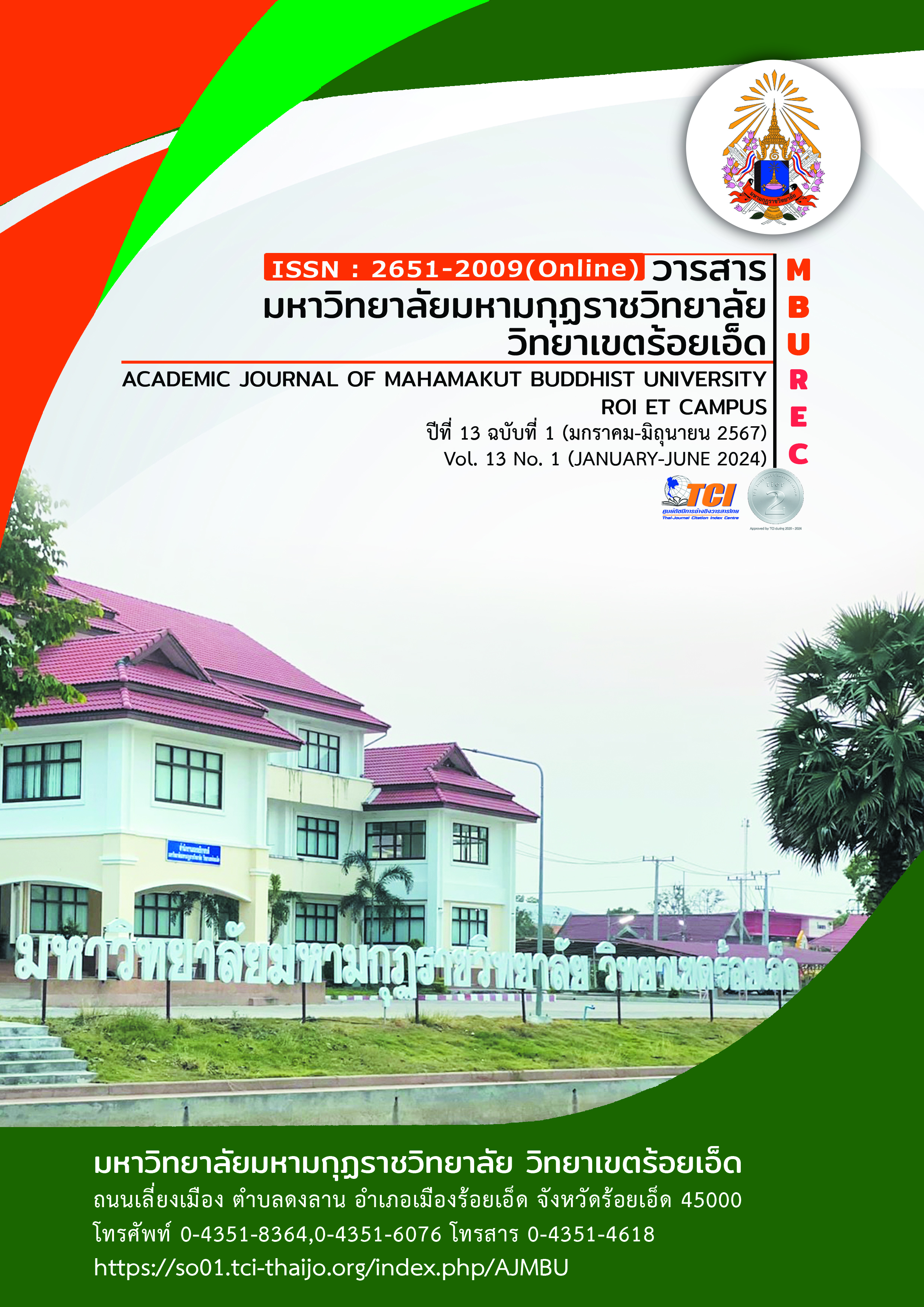ANALYZE THE COMPONENTS OF VISIONARY LEADERSHIP BASED ON FOUR PATHS TO ACCOMPLISHMENT OF SCHOOL ADMINISTRATORS UNDER ROI ET PRIMARY EDUCATIONAL SERVICE AREA OFFICE 2
Main Article Content
Abstract
The objectives of these research were to 1) study the components and indicators of visionary leadership based on Four Paths to accomplishment of school administrators under Roi Et Primary Educational Service Area office 2 2) examine the validity and structural confidence of the affirmative model of Visionary leadership based on Four Paths to accomplishment of school administrators under Roi Et Primary Educational Service Area office 2. The sample group was 500 of administrators and teachers. The research tools were a 5-level estimation scale questionnaire with content validity between 0.67 – 1.00, the power of each clause was between 0.265 – 0.639, and a reliability value for the entire issue was 0.948. The statistics used in data analysis were frequency, percentage, mean and standard deviation. Verify model consistency and suitability with empirical data and finding structural confidence.
The results showed that: 1. The components and indicators of Visionary leadership, Overall, it was appropriate at a high level. When considering side by side: there was a high level of suitability in all 5 aspects, sorted from the highest side to the lowest by average were empowerment, teamwork, being a role model, creative thinking, and vision creation. 2. Structural validity verification results and the structural confidence of the constituents and indicators of visionary leadership based on Four Paths to accomplishment of school administrators under Roi Et Primary Educational Service Area office 2, all 5 components, 17 indicators ranked 1 and 83 indicators ranked 2, were statistically significant at the .05 level. They were rankled according to the component weight (λ) in descending order as follows: 1) Empowerment component (λ = 0.791) 2) Teamwork component (λ = 0.656) 3) Exemplary component (λ = 0.656) good (λ = 0.611) 4) creative thinking component (λ = 0.573) 5) vision formation (λ = 0.544), respectively. From checking the structural integrity visionary leadership based on Four Paths to accomplishment of school administrators under Roi Et Primary Educational Service Area office 2, the model had construct validity which was considered from χ2 2 = 17.441, df = 12, P - Value = 0.165, CFI = 0.955, TLI = 0.960, SRMR = 0.030, RMSEA = 0.003, χ2/df = 1.453 < 2 and construct reliability (R2) was between 0.544 - 0.791 which was the criteria value. It showed that the model was consistent and suitable for the empirical data.
Article Details

This work is licensed under a Creative Commons Attribution-NonCommercial-NoDerivatives 4.0 International License.
References
ทัศนียา ชื่นเจริญ. (2561). ภาวะผู้นำเชิงวิสัยทัศน์ของผู้บริหารสถานศึกษาที่ส่งผลต่อการเป็นชุมชนแห่งการเรียนรู้ทางวิชาชีพของโรงเรียนสังกัดสานักงานเขตพื้นที่การศึกษามัธยมศึกษา เขต 8. วิทยานิพนธ์ปริญญาการศึกษาดุษฎีบัณฑิต สาขาวิชาการบริหารการศึกษา. บัณฑิตวิทยาลัย : มหาวิทยาลัยราชภัฏนครปฐม.
เทพสุดา แพงจันทร์ศรี. (2560). การพัฒนาตัวบ่งชี้และเกณฑ์การประเมินภาวะผู้นำเชิงวิสัยทัศน์ของผู้บริหารสถานศึกษาสังกัดเทศบาล. วิทยานิพนธ์ปริญญาการศึกษาดุษฎีบัณฑิต สาขาวิชาการบริหารการศึกษา. บัณฑิตวิทยาลัย : มหาวิทยาลัยราชภัฏมหาสารคาม.
นิกัญชลา ล้นเหลือ. (2554). โมเดลสมการโครงสร้างภาวะผู้นำเชิงวิสัยทัศน์ของผู้บริหารสถานศึกษาขั้นพื้นฐาน. วิทยานิพนธ์ปริญญาปรัชญาดุษฎีบัณฑิต สาขาวิชาการบริหารการศึกษา. บัณฑิตวิทยาลัย : มหาวิทยาลัยขอนแก่น.
ไพฑูรย์ สินลารัตน์. (2553). ผู้นําเชิงสร้างสรรค์และผลิตภาพ : กระบวนทัศน์ใหม่และผู้นําใหม่ทางการศึกษา. กรุงเทพมหานคร : โรงพิมพ์แห่งจุฬาลงกรณ์มหาวิทยาลัย.
วรลักษณ์ ชูกำเนิด. (2557). โรงเรียนแห่งชุมชนการเรียนรู้ทางวิชาชีพครูเพื่อการพัฒนาวิชาชีพครูที่เน้นผู้เรียนเป็นหัวใจสำคัญ. วารสารวิทยบริการ มหาวิทยาลัยสงขลานครินทร์. 25(1). 93-102.
สำนักงานคณะกรรมการการศึกษาขั้นพื้นฐาน. (2564). ระบบฐานข้อมูลข้าราชการครูและบุคลากรทางการศึกษา. สืบค้นเมื่อ 1 กุมภาพันธ์ 2564. จาก https://data.bopp-obec.info/personal/login.php
Comrey and Lee. (1992). A First Course in Factor Analysis. 2nd ed. New York : Psychology Press.
Kotter. (1988). The Leadership Factor. New York : Free Press.
Meredith. (2008). The Relationship of Emotional Intelligence and Transformational Leadership Behavior in Non-Profit Executive Leaders. Dissertation Abstracts International. 68(11). 810-A.
Robinson. (2007). The Principle of Creative Leadership. New York : McGraw-Hill.
Sashkin. (1988). The visionary leader. In J. A. Conger & R. N. Kanungo, Charismatic leadership: The elusive factor in organizational effectiveness. New York : Jossey-Bass.


